The Five Basic Food Groups
Table of Contents
Have you ever asked yourself: “What is food?” Or, is it okay to always eat the same thing? Food is essential for life as it is the “fuel” for our body. To grow healthy, we must eat in a balanced and varied way. That is why we must eat food from all basic food groups.
The amounts of food that you should consume will change according to your age, your gender and the physical activity you perform daily. A baby should not eat the same amount and variety of foods as a pregnant woman or an athlete. Here we will explain the five basic food groups, what they contribute to the body and what are the functions of each group.🍎
What are the Basic Food Groups used for?
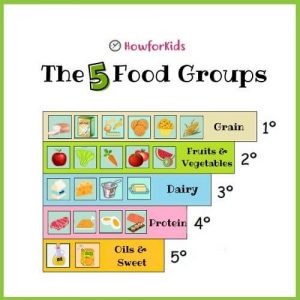
Food groups are used to educate in nutrition and healthy eating. They provide the necessary information to learn what a balanced diet is, which will allow us to maintain our health and live a full life. Knowing the groups, you will learn what is convenient to consume and what could harm your health when you consume in excess.
How are Foods classified into Food Groups?
There are several ways to classify foods and they are all correct. It is possible for the same food to be part of more than one group because foods, in general, contain more than one nutrient. For example, breast milk is an excellent food for the development of babies and mammals in general. It contains all the necessary nutrients for proper growth and development. It provides all the nutrients: Carbohydrates, proteins, fats, vitamins, minerals and water.
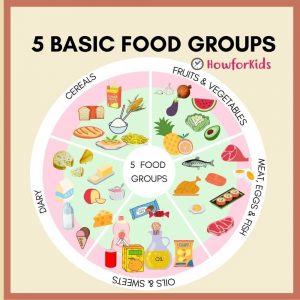
Food Classification Groups: Functions, Sources and Examples
- According to the nutrient they provide.
- According to expiration time (perishable and non-perishable).
- By their origin or where they come from (animal, vegetable or mineral)
- According to the function they develop in the body.
In this article we are going to use the basic classification into 5 groups according to the nutrients they contain and offer to the body. Foods are classified into 5 five basic groups. Foods that are part of the same group provide basically the same nutrients. This is a simple way to group them according to the nutrients they contribute to our body since each group is made up of foods that are similar in quality and nutritional composition.
What are the 5 Basic Food Groups?
They are used to group food according to the nutrients they contribute to the body:
- Group 1: Cereals and derivatives
- Group 2: Fruits and vegetables
- Group 3: Dairy and derivatives
- Group 4: Meat, eggs and fish
- Group 5: Oils and sweets.
*Note: There are those who add a 6th group because they divide the group of fruits and vegetables in two. But the nutrients provided by both groups are the same.
Food and Nutrients: Are They the Same? What are Nutrients?
Read also: Nutrients in food Types and Functions
No, food and nutrients are not the same. Let’s define what is a nutrient and what is food. Nature provides us with a great variety of foods of animal, vegetable and mineral origin. The food industry also brings us more and more processed products to eat.
What is Food?
• Food is any substance or mixture of natural or manufactured substances that serve to provide matter and energy to the body.
• Nutrients are the chemical substances that are in food, essential for the development of life.
Classification of Essential Nutrients
There are six major nutrients:
- Carbohydrates.
- Proteins.
- Fats.
- Minerals.
- Vitamins.
- Water
Based on the amount of nutrients that each person needs to consume on a daily basis, these nutrients are categorized into two groups. These are macronutrients, which should be consumed in fairly large amounts, and micronutrients, which are only required in small amounts.
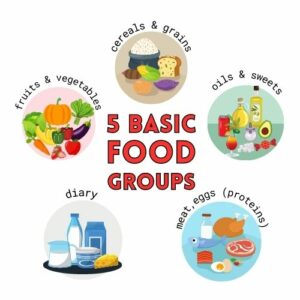
Macronutrients
‘Macro’ means large. As their name suggests these are nutrients which people need to eat regularly and in a fairly large amount. They include carbohydrates, fats, proteins. These substances are needed for the supply of energy, growth, for metabolism and other body functions. Macronutrients provide a lot of calories but the number of calories provided varies depending on the food source. For example, each gram of carbohydrate or protein provides four calories, while fat provides nine calories for each gram.
Micronutrients
As their name indicates (‘micro’ means small) micronutrients are substances which people need in their diet in only small amounts. These include minerals and vitamins. Although most foods are mixtures of nutrients, many of them contain a lot of one nutrient and a little of the other nutrients. Foods are often grouped according to the nutrient that they contain in abundance.
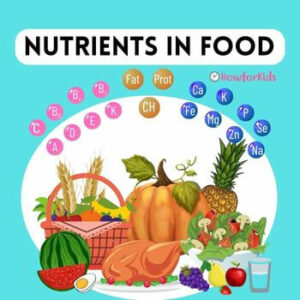
What happens when Nutrients are lacking? What if you consume them excessively?
- Diseases due to deficiency: In these cases, malnutrition, anemia, osteoporosis, scurvy, or rickets can appear.
- Excess diseases: Obesity. In the case of celiac disease, the body “poorly processes” gluten.
Teach kids about Food groups: Food Guide Pyramid
We are going to explain:
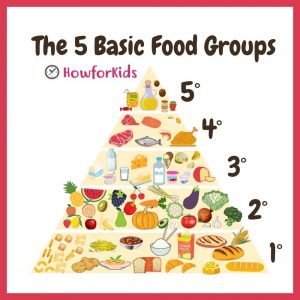
- What FOODS are in each group.
- NUTRIENTS from each group.
- FUNCTIONS of each group.
Essential Food Groups
1st Group: Cereals and Starches
Foods Group 1 with Examples 🍞
– Cereals: wheat, oats, barley, rye, rice, corn, etc. Whole grains add fiber, vitamins and minerals to the diet.
– Bread: wholemeal and white bread.
– Cookies: wholegrain, water, rice cookies, sweet cookies, etc.
– Pasta: simple (dry noodles) and stuffed pasta (cappelletti, tortellini, ravioli, etc)
– Legumes: peas, chickpeas, broad beans, beans, lentils, soybeans, etc.
– Starchy vegetables: sweet potato, corn, potato, cassava.
Nutrients Group 1
– Complex Carbohydrates of slow absorption.
– Vitamins of the B complex.
– Minerals: iron (Fe)
– Fibers.
– Vegetable proteins.
Functions Group 1
The function of this food group is to provide energy for daily activities (moving, thinking, breathing). Carbohydrates are the main source of energy for healthy people. The amount to be consumed must be proportional to the energy expenditure of each one, that will be conditioned by age, sex and physical activity. More active people, who expend a greater amount of energy, can eat more of these foods than sedentary people of the same age and gender.
The lack or lack of this food group will cause people to feel weak, without strength and without the desire to study or carry out daily activities. If the deficiency is prolonged in time, the weight will be affected and the person will have malnutrition.
Excess carbohydrates cause obesity and changes in blood glucose (blood sugar content).
2nd Group: Fruits and Vegetables
Foods Group 2 🥬
- Group A vegetables: (3% carbohydrate content) Chard, chicory, chili pepper, celery, aubergine, watercress, broccoli, thistle, cauliflower, endive, asparagus, endive, fennel, mushrooms, lettuce, turnip, cucumber, radish, radish, radish, cabbage, Brussels sprouts, tomato, zucchini.
- Group B vegetables: (8% carbohydrate content): Artichoke, fresh peas, onion, scallions, bean sprouts, green beans, broad beans, turnips, hearts of palm, leeks, beets, carrots, squash.
- Group C vegetables: (20% carbohydrate content) Sweet potato, corn, cassava, potato.
Fruit Classification
- Group A fruits: (average 10% carbohydrate content) Pineapple, Blueberry, Persimmon, Cherry, Plum, Apricot, Peach, Strawberry, Pomegranate, Currant, Guava, Cherry, Kinoto, Kiwi, Lime, Lemon, Tangerine, Mango, Apple, Melon, Orange, Papaya, Pear, Watermelon.
The fruits of this group provide approximately between 40 and 80 calories per 100 grams.
- Group B fruits: (20% carbohydrate content) Banana, Date, Fig, Grape.
100 grams of these fruits provide more than 150 calories.
- Exception: Avocado and coconut could be included in a separate group, which although they provide few carbohydrates (10 mg or less) contain high amounts of fat (more than 35%). They are also included in the group of fats.
Nutrients Group 2
– Simple Carbohydrates (they are quickly absorbed, they pass quickly into the bloodstream)
– Vitamins A and C. (They are called antioxidants)
– Minerals: Potassium (K), Iron (Fe), Magnesium (Mg), and Folic Acid.
– Fibers.
Basically, they provide little fat and low calories (exceptions: coconut and avocado whose fat content is higher).
Fun Facts about Vitamins
Vitamins do not provide calories.
Unlike carbohydrates, proteins, and fats, vitamins do not provide energy. Vitamins are essential for the conversion into energy of these basic components of food. They also protect us from diseases and infections and strengthen the body’s defenses. The body does not produce vitamins, but it does store them and use the reserves it has.
What happens if we don’t eat vegetables and fruits?
A lack of vitamins produces diseases such as rickets, osteoporosis, anemia, growth arrest and a series of specific symptoms that usually affect the skin, vision, and other parts of the body. However, avitaminosis (deficiency of one or more particular vitamins) is usually very rare, since it is only suffered by those people who only eat a single type of food. The most common is the presence of hypovitaminosis due to an unbalanced diet.
Read also: Five Sense Organs for students
What happens if we incorrectly prepare fruits and vegetable?
The vitamin content that food contains (especially fruits and vegetables) varies according to the freshness of the same, climatic conditions of cultivation, conservation and subsequent preparation. Improper handling of fruits and vegetables during processing and prolonged cooking destroy much of their vitamin content. Squeezing a juice well in advance is not convenient, you should consume it right away.
Fiber Functions
What are Fibers for? How does eating Fibers benefit us?
Although fiber does not provide nutrients, it is essential to include it in your daily meals. Among the functions of fibers, they mainly contribute to maintaining a balanced diet, retaining fluids and providing the necessary volume to eliminate waste from the body. It helps the intestine to function more regularly (to use the bathroom). This is important since as the years go by, the intestine loses mobility and the tendency to constipation increases.
Other Effects of Fibers
- Foods’s rich in soluble fibers help to lower blood cholesterol, thus reducing cardiac risk. These fibers bind with cholesterol, eliminating it from the body.
- Another benefit is that they slow down the absorption of glucose (due to the formation of gels in the intestine). This lowers the amount of glucose in the bloodstream.
- Eating foods rich in soluble fiber increases the feeling of fullness because they absorb water and hydrate themselves within the body. This delays gastric emptying, keeping food in the stomach for longer.
- They neutralize the acid secretions in the stomach.
- Secondary function: Lose weight. If you replace the consumption of high-calorie or high-fat foods with those that contain plenty of fiber, you will lose body weight.
3rd Group: Meat and Eggs
Foods Group 3🥩
– Red meat (cow, lamb, hare, pork)
– Poultry meat.
– Fish and shellfish: fresh, packaged fish, shellfish and kani-kama, etc.
– Lean cold cuts: defatted ham, shoulder, tenderloin, pastrami, etc.
– Eggs.🥚
Nutrients Group 3
– Proteins of animal origin (they are complete proteins).
– Iron (Fe) Beef provides double iron content (ferrum) compared to poultry and triple compared to fish.
– Vitamins and Minerals: Zinc, B complex vitamins: (B12) and Magnesium.
Functions Group 3
What does our body use iron for?
Iron is a component of the blood that is present in red blood cells. Its function is to transport oxygen to all body organs and tissues.
Iron Fun Facts
Differences between Animal Iron and Vegetable Iron (Hem and Non-Hem Iron)
The iron found in foods of animal origin such as liver, red meat, kidney, blood sausage is called “Hem Iron” and is easily assimilated by the body.
Iron from plant sources such as legumes, whole grains, dark green vegetables, is called “Non-Hem Iron” and is assimilated by the body only if it is accompanied by facilitators of its absorption: such as ascorbic acid (vitamin C) and proteins.
Accompanying the non-heme iron with a small portion of meat, milk, fish, egg white or a raw vegetable or a citrus juice or a dessert that contains them, contributes to its absorption.
There are foods that inhibit the absorption of Iron
They are called Iron Absorption Inhibitory Factors. They are taken into account in cases of disease such as anemia. They are phytates, oxalates and tannins. Phytates are found in wheat bran and in the skins of cereals, oxalates in leafy vegetables such as chard, spinach, lettuce. Foods’s rich in tannins cause a sensation of harshness and are present in foods such as tea, coffee, spinach, raisins and some fruits such as pomegranate, persimmons, quince or green apple.
Iron (Fe) deficiency: causes anemia
4th Group: Dairy
Foods Group 4 🥛
– Whole milk, part skim, skim and low lactose milk.
– Yogurt and cultured milk: natural, with cereals, fruits, whole and skim.
– Spread cheeses (they are low in Calcium), compact, lean and fatty cheeses.🧀
Nutrients Group 4
– Calcium (Ca)
– Proteins of animal origin
– Fat of animal origin
– Phosphorus (P)
Functions Group 4
Calcium deficiency causes disorders in the bones (osteoporosis) and teeth (dental caries, tooth decay).
5th Group: Fats and Sugars
Foods Group 5
Fats should be eaten in moderation.
– Butter, heavy cream
– Oils (from seeds: soy, corn, sunflower) from fruits (olive, grape)
– Margarines, mayonnaise, dressings such as dressing, dried fruits.
– Olives, avocado, coconut.
Nutrients Group 5
They provide fat-soluble vitamins and essential fatty acids.
Functions Group 5
Fats incorporate essential fatty acids that are not synthesized by the body. They are Omega-3 and Omega-6.
Fun fact of Group 5
In this group are also complementary foods, the absence of which does not produce any deficiency. They participate in our habits and their consumption is optional:
– Natural sweeteners: Sugar, honey, glucose, fructose.
– Sweets (jams and compact sweets), jellies, dulce de leche (classic and diet). In general they provide only calories.
– Salt, condiments, drinks, jellies, infusions, broths.
Classification of Foods according to their Function
We have a complete article with this information: How are Foods classified according to their Function? Foods are classified into:
- Energetic food
- Structural and Plastic (build muscles)
- Regulatory and protective.
Read also: Classification of Foods according to their Function
Eat healthy and varied! See you next time!😊

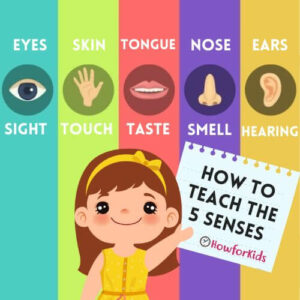
thank you i am doing a project.